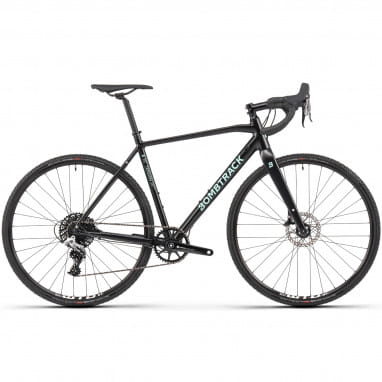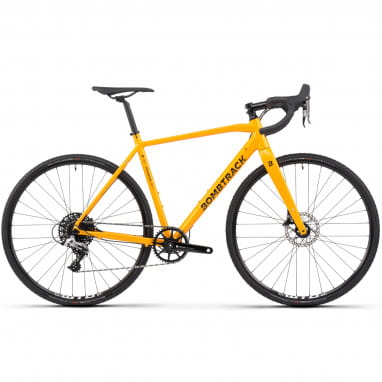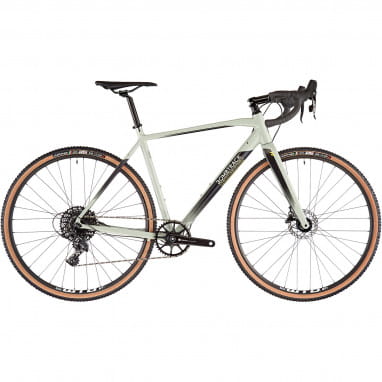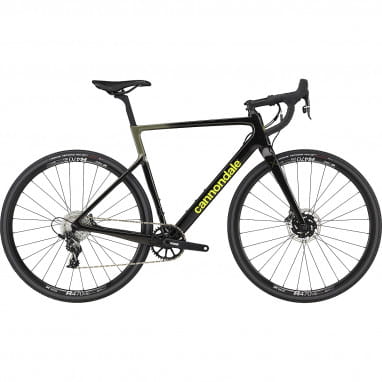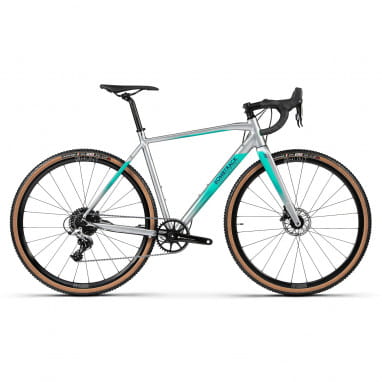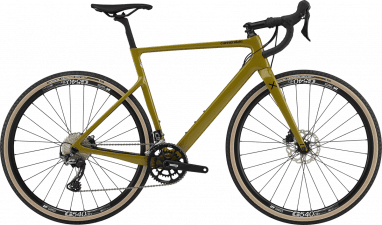Racing bikes have many fans. That's not surprising, because racing bikes are quite simply beautiful. Whether as a stylish retro bike with a slim steel frame or as a featherweight carbon bike with a little more "meat", racing bikes are not only top athletes that impress with maximum performance, they are technically sophisticated and real eye-catchers. They only have one handicap. They don't work on any surface other than slick roads. They don't just ride badly, they don't actually ride there at all, because every little stone on the road can cause the handlebars to break out. For this reason, road racing bikes stayed where they belonged for a long time, on the road namely. But then cyclocrossers (aka cyclocross bikes or CX bikes) came along and made road bikes suitable for off-road use, long before the gravel bikes that are so popular today appeared on the scene.
As early as the early 1900s, the first "cross-country races" emerged, with ace cyclists slashing their way through the countryside on their bikes. In contrast to the already established road races, the main aim here was to plough through as much mud as possible as quickly as possible. To ensure that there is enough mud, the races still take place mainly in autumn and winter. To ensure that the riders don't get bored along the way, the routes were and are chosen in such a way that there are also numerous obstacles lurking along the way. Tree trunks. Streams. Gradients that a bicycle simply can't manage. To prevent these races from totaling people and bikes every time, racing bikes were gradually adapted to meet the demands, and cyclocrossers were born.
Long before mountain bikes took bicycles off-road, cyclocross races not only tested the athletic fitness of participants, but riding technique, nerve and just plain off-road ability are also essential to reach the finish line in a cross-country race - an exciting change from the top speeds of "normal" bike races for spectators and riders alike.
And now the interesting part - the bikes to go with it:
The shortcut:
This is a cyclocrosser - Things to know about cyclocross bikes
What exactly a cyclocross bike can do and when you should get one is actually explained very quickly, because these bikes have a very limited range of use. They are actually mainly ridden by professional athletes and amateur athletes who participate in the cyclocross races. A shame really, because they bring a lot of interesting features to the table.
Cyclocross bikes are tough
If you want to ride your bike cross-country, it should be one thing above all else: durable. If the chain goes bye-bye with every little stone and the drive shows the first signs of wear after a few months, the good piece quickly ends up in the corner of the bike basement. That's why the frame of a cyclocross bike is not quite as delicate as a road bike frame, but it can withstand more. The components must not be directly blown away by a lot of abrasion, durability is also the top priority here. You'll tend to find slightly higher-quality brake systems and shift groups here, because that's the only way to match performance with requirements.
An aggressive racing geometry
Cyclocrossers are racing machines, because people who buy such a bike usually want to race cross-country, or at least train for it. You're put in a low, stretched out riding position, the aerodynamics are so perfect. The comfort? Doesn't matter. You can, of course, tweak this with your choice of handlebars, stem and seatpost. Just for the sake of completeness, a cyclocross has race handlebars (also dropbar).
Other than that, the classic racing genes are mixed with a big helping of maneuverability, so you'll be able to get every turn on the road, even in the woods. The frames have excellent stiffness values, so they are particularly efficient, which pays off in head-to-head racing.
Cyclocross bikes are available with aluminum or steel frames.
Generally, cyclocross bikes have a rather limited target group, and the number of models is correspondingly low. Therefore there are hardly any special versions for ladies.
The difference between cyclocrossers and road bikes
In terms of forward-stroking geometry, road bikes and cyclocrossers differ little; one frame serves as the basis for both for some manufacturers. In general, a cyclocross is just as race-oriented as a road bike, its off-road features just make it much more versatile. <however, this="" does="" not="" make="" it="" more="" suitable="" for="" everyday="" use! <="" p="">.
The most obvious difference to the road bike is the greater tire clearance of the fork and rear triangle. On narrow, slick road bike tires, you'd quickly be screwed off-road. Under the wide, chubby tires with you can also take dirt roads, forest floor or even mud.
These bikes, however, like to be a bit heavier than pure race bikes, but still lighter than most other bikes!
The difference between a cyclocrosser and a gravel bike
A gravel is the cozy relative of the road bike. Everything runs much more relaxed here. The sitting posture is more upright and therefore more comfortable. So a Gravel is also suitable for long distances and not only for selective best performance during a competition. Here, the tires may also be a little wider and more profiled, so even cobblestones or gravel are no obstacle.
Gravel bikes are additionally often best equipped, there are bike lights, fenders and racks. Even lowriders are not uncommon on a gravel bike. The latter make the bikes absolutely suitable for touring. Even if you want to use your bike as an everyday vehicle, a Gravel is a good choice, the equipment makes it safe enough for road use.
The difference between a cyclocross and a mountain bike
Now you might think that cyclocross bikes became obsolete with the invention of mountain bikes. Fortunately, though, it's not the case. Granted, the climbing and downhill capabilities of an MTB are generally better. However, uncompromising speed is the trait that CX bikes have over mountain bikes, apart from that they are significantly lighter in most cases. The lack of shocks requires less maintenance and adjustment.
The optimal tires for a cyclocrosser
Wide tires provide the traction needed to get around off-road, in the wet, or on loose surfaces. Some tread also increases off-road ability. For official off-road races, guidelines allow 33mm tire width. If you're not racing at UCI level, you can also go a little wider, narrower works too of course.
In general, cyclocross bikes ride on 27.5 or 28-inch wheels, but versions with 29-inch tires are also available.
Cyclocross bikes have discs!
Brake later and you'll be faster longer, but you'll have to decelerate at some point, that's for sure! While rim brakes are still popular and used a lot on road bikes, disc brakes are now standard on cyclocross bikes. They weigh a little more, that may be. But they simply decelerate better, especially in the wet. That's an advantage no rider wants to pass up on mountainous trails and in wet conditions.
Cross gears
To keep the bike from unnecessarily straining your shoulder on a carry, lightweight 1-speed gears are often installed these days, 1x11 or 1x12 drives with a wide range make the bikes adaptable, but don't weigh them down too much.
Mostly there are very small gears for steep climbs, big gears help you make distance efficiently. The best way to find out the right range for your adventures is on generous test rides, with choices stretching from 11-26 to 11-36 to 11-42 cassettes (depending on manufacturer and groupset).
1x gears are not only lightweight, they have another advantage: the chain won't jump off or jam during shifting. Advantage number 3: If there is no gap between two chainrings, no dirt can get stuck there.
Generally, the higher-end groupsets from well-known names like SRAM or Shimano are installed on most cyclocross models. This way you can be sure that the gears will work smoothly and for as long as possible. Cyclocross bikes are now also available with wireless, i.e. electronic shifting.
There are models with multi-shifting, but they are becoming fewer and fewer every year.
Featherweight cyclocross bikes
Part of the challenging cross races are obstacles that even the most versatile cyclocrossers can't negotiate. Then only one thing helps, carry bike on your shoulder and around the obstacle. Also, if you want to stay ahead in the race, every gram of bike weight counts. For this reason, these bikes are built especially light, the exact weight of course depends on the particular model, equipment or frame material. How much a cyclocross bike weighs is roughly in the same weight range as road bikes, but usually a cyclocrosser weighs a bit more. The sturdier frames, the more durable components and last but not least the more tire material is responsible for this. When buying a cyclocross bike, expect a package that weighs about 8 to 9 kilos (without packaging material, of course). As always when it comes to bikes, the weight goes down as the price goes up.
Overall, a cyclocross bike is certainly not a bike for everyone. For fast rides on the road, a road bike is better suited. For touring and everyday riding, a gravel is the way to go. If you want to participate in cyclocross races, buy one of the nice cyclocross bikes in our online shop! Even if you want to be super-sporty in everyday life without a lot of luggage but on changing surfaces, a cyclocross is a cool alternative to a road bike.
Is a cyclocrosser the right bike for you?
As stated earlier, a cyclocrosser is not a bike for everyone. Before gravel bikes existed, they were the more versatile alternatives to road racing bikes. They are of limited use in everyday riding, their geometry simply makes them too uncomfortable.
If you're looking for a bike that mills forward aggressively, no matter what's in front of it or underneath it, you're golden. If you want to buy a lightweight bike that takes excellent propulsion seriously, a cyclocross bike is made for you. If the thrill of speed appeals to you, go for it! Comfort is your sofa, performance is what counts on the bike? You want to go fast and conquer any terrain? You guessed it, buy a cyclocross!
If you race cyclocross, or at least want to train for it, there is of course no viable alternative.
The features at a glance:
- athletic, fast geometry
- Splashy propulsion
- wide, all-terrain tires
- robust components
- robust, functional design
- more of a sports machine than a means of transport
How does a cyclocrosser ride?
It's not really part of the riding experience, but if you need to carry your bike, a lightweight cyclocrosser is obviously best. It doesn't always have to be a log on the track in the woods. The subway, the stairs to your apartment or the stairs to the bike cellar, if you love your bike, you don't just push it. Sometimes you just have to carry it on your hands.
Other than that, a cyclocross bike rides fast on changing surfaces, but it's not particularly comfortable. You can use it for bike rides where the focus is on speed and "getting from A to B fast," not picnicking-by-the-lake. It's a sensational training tool.
If you want to make your daily commute fast and athletic, you can do that on a cyclocrosser, too. In a crowded city, the necessary handling is of course an advantage. The city shouldn't be too small, though, or it'll be behind you before you know it!
The tires have a huge impact on the handling of a bike, since you're riding thicker tires here, the feel isn't quite as direct and precise as you know it from a road bike, but nowhere near as spongy as a trekking bike or MTB. Still, you can leave the paved road behind. The other big plus is the make-less efficiency of these bikes. Most of your pedaling power lands directly on the road, it gets the maximum speed out of every pedal. You'll have to make sacrifices in comfort.
The ride at a glance:
- Deep, aerodynamic riding position
- Lightweight, therefore easy to handle and carry if necessary
- dexterous
- fast and efficient
- off-road
What are the advantages of a cyclocross bike?
To cut right to the chase: Cyclocross bikes are fast, nimble, off-road capable, and lightweight. You can only get top speeds and terrain in person in this division. If you like to just follow your nose and don't want to be guided by a road map, a bike like this will always open up new possibilities for you.
Whether you plan fast day tours or training laps, with a cyclocross you can leave the paved road at any time. Thanks to the robust construction and the good components your bike might need a shower every now and then, but constant repairs and workshop visits are not to be expected.
Because it doesn't come with any shocks, it's not only extremely efficient, you also save on expensive shock service and don't constantly ride with the uneasy feeling that something is misadjusted. What's more, it's lightweight, making it easier to handle and load for everyday use and travel.
A cyclocross is lighter and faster than a gravel bike, MTB or touring bike. It is off-road capable, unlike a road bike.
The advantages of a cyclocross bike at a glance:
- excellent propulsion
- lightweight
- Rugged construction with durable components
- off-road capable with no shock service
- more Komoot than Strava
How much does a cyclocrosser cost?
Cyclocross bikes don't come cheap; after all, they're primarily competition-ready and durable too. But what are the acquisition costs you should expect?
The entry-level class starts at about 1200 euros. If you want to try out whether CX training is right for you, you can do your first laps with a bike in this category. Smaller trips on the road and off-road they do easily with, the durability of the components and the function will turn out satisfactory, but excellent rather not. You should not compete with these bikes, because they weigh more than their more expensive counterparts, and you will also have to make sacrifices in terms of performance.
From 2000 to about 3000 euros you can buy a mid-range cyclocross bike. Frame, brakes, gears, all components are here significantly better and above all more durable. The function improves, especially with the circuits you can count on soft, precise transitions, the entire drive is more resistant. The tyres have a better grip and you can also look forward to better puncture protection. The bikes in this price range are also suitable as a second bike for road cyclists in autumn and winter.
From around 3000 euros upwards, there are cyclocross bikes that definitely hold their own in amateur competitions. Here you can shine with hydraulic disc brakes and electronic gears. Carbon frames make the bikes particularly light, some manufacturers can even undercut the 1 kilo mark! The noble carbon rims are equipped with puncture-proof and light tubeless tyres or the wheels are at least tubeless-ready. You also get gimmicks like a dropper post. Overall, top CX bikes weigh less than 8 kilograms.
The costs at a glance:
- The entry level starts at about 1200 euros.
- From 2000 to about 3000 euros you can buy a mid-range cyclocross bike.
- From about 3000 euros upwards there are cyclocross bikes of the top class.
What do you need to look out for when buying a cyclocross bike?
The choice of the right bike is sometimes not so easy. By answering the following questions, you can find out which cyclocross is right for you.
- Do you race cyclocross or train seriously for it?
This question will determine the price range you should look in. In this case, the best crosser is just good enough. After all, you don't want to lag behind the others just because the material is no good. Even if you don't fancy regular visits to the bike repair shop, it's worth buying a high-quality bike.
If you're looking for a bike on a limited budget, you should definitely check out our Sale. There you'll find last year's models, promotional prices, and other bargains.
You've already read it above, cyclocrossers are definitely off-road capable. This means that you can make progress with it even on dirt roads or cobblestones. The more challenging the terrain you'll be riding on, the less trouble a bike from a higher price range will be.
If you look for plenty of tire clearance when you buy (i.e., 40mm or more) you have the option of experiencing a bit more ground variety with wider tires.
If you don't fancy becoming a bike carrier after all, a mountain bike is better, it can handle more difficult terrain if in doubt.
- Do you take luggage with you?
If you want to carry more than you can fit in your ass rocket, pardon thesaddlebag, you might be better off shopping at our Gravels. There are attachment points for all sorts of racks here.
- Are you looking for an everyday bike or a sportbike?
Sure, you can pull up to the office on a cyclocross bike. But the bikes are actually not made for it. For everyday life and the city, gravel bikes with their comfort equipment are simply better suited.
- What care does a CX bike need?
Exactly how long the total work of art will last depends, of course, on use and care. Dust and mud act like sandpaper on a bike's drivetrain. If you're really shuttling through the deepest muck, you should clean your bike meticulously afterwards. If you grease it professionally afterwards, you can expect a long riding time without spare parts. Here in the BMO online shop you can find all necessary bike cleaners and bike care products. Despite all the care, the drivetrain is one of the most important parts of a bike, so you can buy all parts here as bike spare parts. The first thing to get caught, by the way, is usually the bike chain.
Buy a cyclocross from the best manufacturer
Here at BMO Fahrradshop, you'll find cyclocross bikes primarily from the upscale Cologne-based company Bombtrack. The bikes "Made in Germany" convince with a great workmanship, top equipment and a good price-performance ratio.
You can also order everything you need here when you make the woods and fields unsafe with your bike. Besides normal cycling clothes, waterproof rainwear never hurts when it comes to cycling action in autumn and winter! And please never ride without a helmet, especially off-road! To make sure you don't lose your vision on the road, a pair of cycling glasses is an essential accessory when off-roading!
Many bikes, lots of choice - maybe even spoilt for choice? Here on BMO, you can easily compare different bike divisions. We explain what mountain bikes, urban bikes and city bikes, trekking bikes, dirt bikes, road bikes and e-bikes can do. Plus, we'll help you buy a cool kids bike for your little one. Just read our buying guides to find out which bike is the best fit for you!
